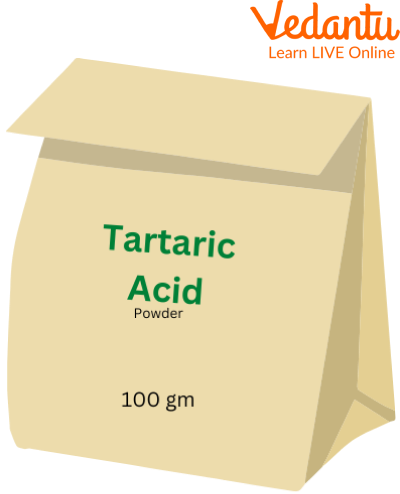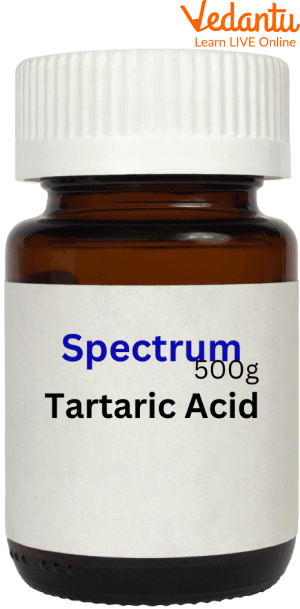




Overview of Tartaric Acid
Kids, do you know which acid is found in your favourite tamarind sauce? Yes, it’s tartaric acid. Tartaric acid is an organic acid found in various fruits, plants, and wine. People use tartaric acid in various ways in different industries. Tartaric is used commercially as a flavouring and an additive agent in food industries. Due to its unexceptional uses, it is also used in many industries like photography, pharmaceuticals, tanning, ceramics, and textile printing.
We will discuss the uses of tartaric acid in detail in this article. So let’s move further and read the article!

A Packet of Tartaric Acid
What is Tartaric Acid?
Tartaric acid is a crystalline white solid acid that occurs naturally. It is an organic acid and is found in many fruits, such as citrus fruits, tamarind, bananas, and, most notably, grapes. Tartaric acid is also used as a food additive in baking powder. The chemical name of tartaric acid is dihydroxybutanedioic acid. It is one of the most common and widely distributed plant acids and is a dicarboxylic acid.
The history of tartaric acid goes back to 1769 when it was isolated by Carl Wilhelm Scheele, a Swedish chemist, for the first time. Tartaric acid was already in observation by the Romans and Greeks. They observed 'tartar' as a partially purified form of acid. Tartaric acid is obtained as a by-product of wine fermentation.
Tartaric acid is a crystalline solid with a pungent taste and is highly soluble in water. It is also used in foods for its antioxidant properties and sour taste.

Grapes Contain Tartaric Acid
Important Points About Tartaric Acid
Let's see some important points about tartaric acid:
Chemical Formula: C4H6O6
Chemical Name: Dihydroxybutanedioic acid
Molar Mass: 150 gram per mole
Density: 1.79 grams per millilitre
Melting Point: 171°C
Boiling Point: 275°C
Appearance: Crystalline solid
Solubility: Soluble in water
Uses of Tartaric Acid in Food
Tartaric acid is widely used in the food and preservative industry. Tartaric acid is also a major component of the baking industry as it is used as a leavening agent in baking powder. It also enhances the colour and fruit flavour of the bakery items. The salt form of tartaric acid is called the 'cream of tartar and is a preservative agent.
Pharmaceutical Uses of Tartaric Acid
Medicinal uses of tartaric acid are because it has anti-inflammatory and antioxidant properties, which help in keeping our immune system healthy. Pharmaceutical uses of tartaric acid include the formulation of drugs for heart diseases, effervescent tablets and powders, and antibiotic tablets.
Tartaric Acid Uses for Skin
Along with the food and pharmaceutical industry; tartaric acid is also of great help in the cosmetic industry. Many cosmetic products like creams, moisturisers, and serums have tartaric acid in their preparation. It is an anti-ageing acid that helps maintain the skin's pH level. Tartaric acid is used in the beauty industry as a skin-lightening agent.

Medicine Containing Tartaric Acid
Summary
In this article, we learned that tartaric acid is an organic acid found in various plant products. It is found in fruits we eat, beauty products we use, and even some medicines we take. It is a diprotic acid with two hydrogen atoms on each molecule that can be ionised in water.
We have also discussed many uses of tartaric acids, such as improving the taste of oral medications, acting as a leavening agent and baking soda, as antioxidants, in foods that give a sour taste, inducing vomiting, making silver mirrors and dyeing and textile industry in this article. Due to all these benefits and uses, tartaric acid has become a major component of our lives.
FAQs on Uses of Tartaric Acid
1. What is tartaric acid and where is it commonly found?
Tartaric acid is a naturally occurring, white crystalline organic acid. It is a dicarboxylic acid found in many plants, most notably in grapes. Other common natural sources include tamarinds, apricots, bananas, and citrus fruits. Its presence in grapes makes it a key component in winemaking.
2. What are the main uses of tartaric acid in the food industry?
In the food industry, tartaric acid is primarily used as an acidulant to impart a sharp, sour taste to foods and beverages. It also acts as an antioxidant and a flavour enhancer. It is a key ingredient in cream of tartar and is widely used in soft drinks, gelatin desserts, jams, and jellies.
3. How does tartaric acid work in baking powder?
Baking powder is a mixture of baking soda (sodium bicarbonate) and a dry acid like tartaric acid. When baking soda is heated, it produces carbon dioxide for leavening but also forms sodium carbonate, which has a bitter taste. The role of tartaric acid is to neutralise the bitter-tasting sodium carbonate, ensuring the final baked product has a pleasant taste.
4. What is the main difference between tartaric acid and citric acid?
The main differences between tartaric acid and citric acid are their source and taste profile. Here's a breakdown:
- Source: Tartaric acid is primarily derived from grapes and tamarinds, whereas citric acid is found in citrus fruits like lemons, oranges, and limes.
- Taste: Tartaric acid provides a stronger, sharper sour taste compared to the milder, fruitier sourness of citric acid.
- Application: Due to its taste, tartaric acid is often preferred in grape-flavoured products, while citric acid is more common in citrus-flavoured items.
5. Is tartaric acid a strong or a weak acid?
Tartaric acid is classified as a weak organic acid. While it is stronger than some other plant-based acids like malic acid, it does not fully ionise in water. It is significantly weaker than strong mineral acids such as hydrochloric acid (HCl) or sulfuric acid (H₂SO₄).
6. Besides food, what are some other important applications of tartaric acid?
Beyond its use in food, tartaric acid has several other important applications:
- Pharmaceuticals: It is used to prepare effervescent powders and tablets that dissolve in water. It also helps in improving the solubility of certain drugs.
- Cleaning: Tartaric acid is an effective agent for cleaning metal surfaces like copper, brass, and bronze as it can chelate metal ions, helping to remove tarnish.
- Industrial Uses: It is used in the silvering of mirrors, tanning of leather, and as a component in Fehling's solution, a chemical reagent used to test for aldehydes.
7. What are the potential side effects of consuming too much tartaric acid?
While tartaric acid is generally recognised as safe (GRAS) in the quantities used in food products, consuming it in very large or concentrated amounts can be harmful. Potential side effects of excessive intake can include gastrointestinal issues like stomach pain, nausea, inflammation, and vomiting. It's always advisable to consume it only as a food additive.









